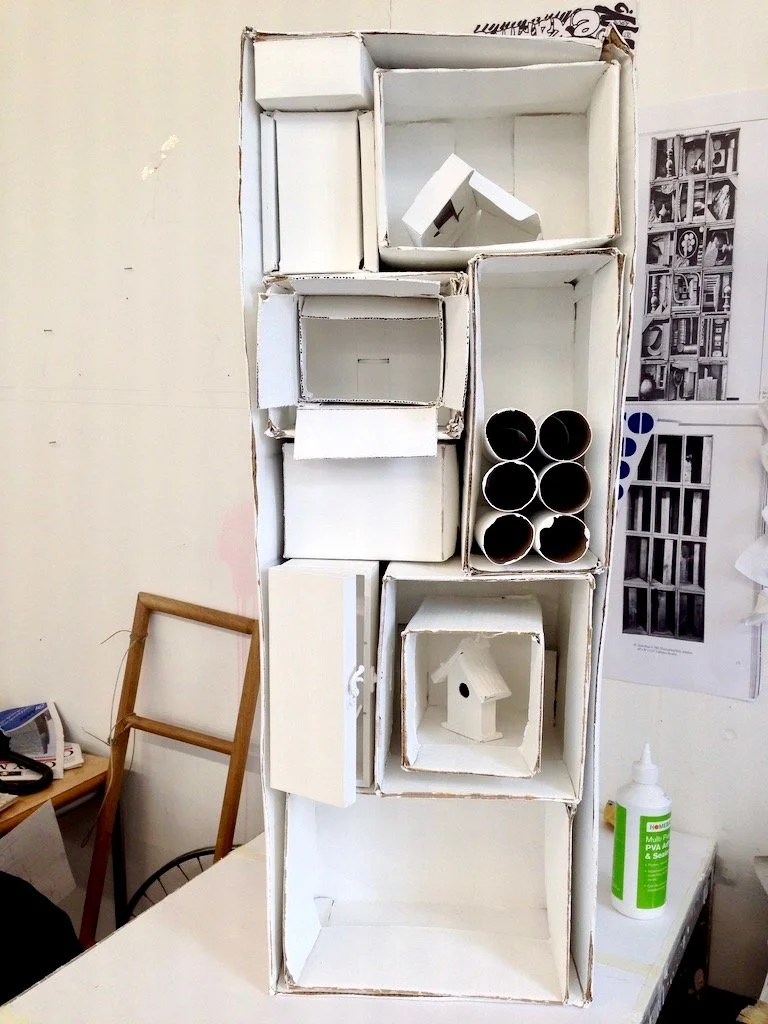Considering my forays into crumpled paper and use of paint, and the formalism of my work, I am thinking more about how certain colours have different relationships with depth, noting Clement Greenberg’s rationale that modernist painting uses its own method for criticising itelf1. I looked at painters such as Donald Judd, who painted the inside of metal boxes to show how colour, reflected against the metal, plays with perceptions of depth; and Phyllida Barlow, who used paint as a sculptural material. I also examined more contemporary artists: Angela de la Cruz who, for her collapsed paintings, takes canvas and applies heavy layers of bold-coloured paint, transforming the form of the painting and making it sculptural; and Tauba Auerbach, who produces series of paintings using canvases that have been folded, sprayed, pulled, stretched and then folded out flat.
Using household paint, this is a selection of matt emulsion colours from the Dulux, Crown, Farrow & Ball, Heritage and Elle Decoration ranges. I painted on plain kraft paper and on kraft paper with an undercoat of Leyland’s white emulsion. Photo Shirley A
I had explored the minimalist approach in 2017 with White Boxes_1, which I created using cardboard boxes that I had collected from various sources, painted white, and then, referencing Junichiro Tanizaki’s In Praise of Shadows, positioned them in and around each other to see what forms and shadows were produced: “We find beauty not in the thing itself but in the patterns of shadows, the light and the darkness, that one thing against another creates… Were it not for shadows, there would be no beauty.”2
White Boxes_1. Painting the found boxes white eliminates their history and allows the viewer to see the forms and shadows they produce. Note in the background, to the right, images of Nevelson’s walls. Photo Shirley A
At the time I was also interested in the nested objects that Louise Nevelson created from detritus collected from the streets of New York, then painted either black or white and reassembled into her distinctive walls. By painting the pieces just one colour negated their histories and in turn unified them into a single artwork/collection. Nevelson said that this also ‘disciplined’ her as an artist in line with the formalist approach3. Regarding the major project, by moving away from regarding the structures as ‘the tree’ or ‘the garden’, and instead focusing on the materiality and the making process, my work becomes more abstract and, therefore, speaks for itself. It is a less obvious proposition for the viewer, allowing them to assess the piece and communicate with it on their own terms.
Minimalism is about boiling things down to their essential parts and I need to avoid thinking, ’This looks like that’ and, instead, consider how ‘X works with or against Y, which in turn produces Z’. By adding colour, I am looking at what the paint does to the substrate and how it transforms the material through the process of experimentation. The test pieces of crumpled paper roller-painted with white household emulsion, which on first sight I compared with an aerial view of ‘snow-capped mountains’, becomes topographical, showing depth and density. It acts as an uplifting base to any colour I add on top of that. With my test pieces, by adding just one colour on top of the white I have developed a palette of zingy ‘Miami’ pastels.
Painted test pieces: An undercoat of brilliant white emulsion on crumpled paper, with a coloured layer on top resulted in an uplifting pastel palette. Photo Shirley A
The secret garden area was originally planned as a place of repose and contemplation at a certain point during a journey of self-discovery, but it is really about marking a turning point – the Eureka! moment. This spot will comprise simple, mound-like forms of colour that will make it stand out from the large vertical structures. The use of colour here is crucial in changing the mood. Buddhist monks use specific colours – for example, deep red for divinity and orange for imparting joy – that function in the psyche and emulate their path to enlightenment. Within the secret garden, colours could be placed in order of personal recovery, for example, blue (soothing), green (healing), red (deep contemplation), orange (energy) and yellow (hope). The uplifting lemon yellow will set the visitor off in a new trajectory.
Clement Greenberg, ‘Avant-Garde and Kitsch’, Forum Lectures (Voice of America), Washington DC, US, 1960.
Junichiro Tanizaki, In Praise of Shadows (London: Vintage, 2002), p. 46.
Brooke Kamin Rapaport, The Sculpture of Louise Nevelson: Constructing a Legend (New York: The Jewish Museum, 2007), p. 8.


